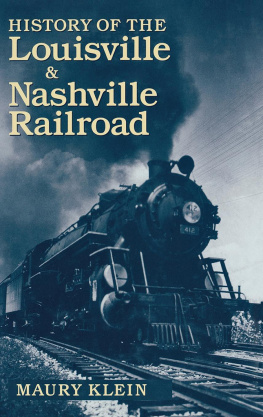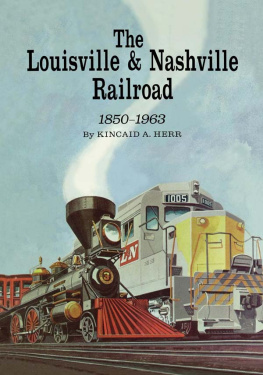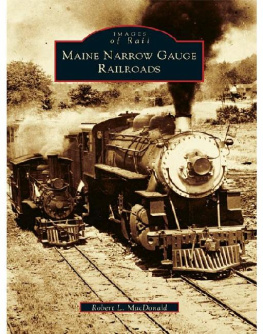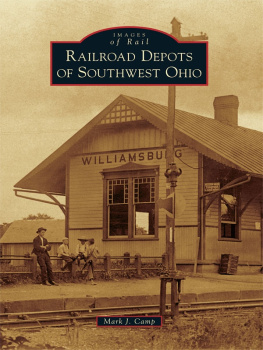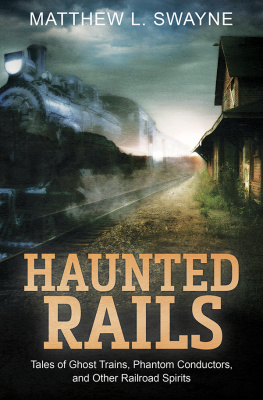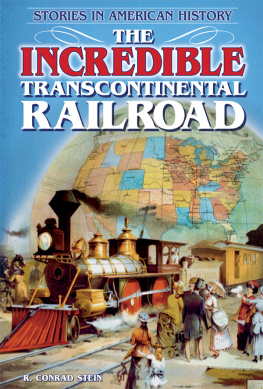History of the Louisville & Nashville Railroad
HISTORY OF THE LOUISVILLE & NASHVILLE RAILROAD
MAURY KLEIN
THE UNIVERSITY PRESS OF KENTUCKY
Publication of this volume was made possible in part by a grant from the National Endowment for the Humanities.
Copyright 2003 by The University Press of Kentucky First published in 1972 by The Macmillan Company.
Scholarly publisher for the Commonwealth, serving Bellarmine University, Berea College, Centre College of Kentucky, Eastern Kentucky University, The Filson Historical Society, Georgetown College, Kentucky Historical Society, Kentucky State University, Morehead State University, Murray State University, Northern Kentucky University, Transylvania University, University of Kentucky, University of Louisville, and Western Kentucky University. All rights reserved.
Editorial and Sales Offices: The University Press of Kentucky 663 South Limestone Street, Lexington, Kentucky 40508-4008
07 06 05 04 03 5 4 3 2 1
Cataloging-in-Publication data available from the Library of Congress
ISBN 0-8131-2263-5 (cloth: alk. paper)
This book is printed on acid-free recycled paper meeting the requirements of the American National Standard for Permanence of Paper for Printed Library Materials.

Manufactured in the United States of America
for my mother and father
Contents
Illustrations
Tables
I NTRODUCTION TO THE N EW E DITION
The original edition of this book appeared exactly thirty years ago. In that year of 1972, Richard M. Nixon was president and made a historic visit to China. That same year he gained reelection by a landslide and five men were arrested for breaking into the Democratic National Headquarters in the Watergate complex. George M. Wallace of Alabama seemed a serious threat for the Democratic nomination until he was shot by a would-be assassin and suffered partial paralysis. Two separate teams of astronauts spent record periods of time on the moon. A stone-age tribe, the Tasadays, was discovered living in caves in the Philippines. Mark Spitz captured seven gold medals at a summer Olympics blighted by the tragic deaths of eleven Israeli athletes. Hurricane Agnes devastated the East Coast, and a strike delayed the opening of the baseball season by thirteen days. The Dow Jones industrial average soared beyond one thousand for the first time ever. Life magazine ceased publication, and All in the Family dominated the television ratings.
When this book appeared that busy year, the Louisville & Nashville Railroad was still one of the major systems of the Southa proud company with a proud history, although its future as an independent road seemed uncertain. Today the central fact about the L & N is that it has ceased to exist as a corporate presence and has become the property of historians and railroad buffs. Its disappearance is hardly unique. Since the late nineteenth century, railroads have followed a consistent pattern of being absorbed by other, usually larger roads until only a handful of lines bearing their original names survive. In this respect the railroads proved a harbinger of things to come, as they did in so many other areas of American life. During the twentieth century the business landscape of America, once crowded with familiar signposts of individual, family, and corporate firms, has seen vast numbers of them swept into the vortex of merger or failure.
The pattern for railroads followed a course that has become all too familiar in modern times. Small local lines, often bearing the names of their terminuses, joined with connecting lines to form longer roads under a new name. In Darwinian fashion the newly extended line usually acquired or built additional mileage or found itself absorbed by a still larger company. Gradually this tangle of older roads and newly built mileage coalesced into a system occupying a territory well beyond that served by any of the original lines. Where once a town or local area identified with its railroad, the blanket of identity now extended over a wide region served by a still-expanding system. Town after town that had once been a proud terminus found itself a way station on a line to somewhere else.
At an even later stage, entire systems began to swallow one another, creating mega-systems, until now only a handful of giants dominate the rail landscape. Scattered about them are clusters of smaller local lines, many of them cast aside by the giant systems or resurrected from the scrap heap of past failures. Since the early twentieth century, this process of consolidation has also been one of attrition as the American rail system shrunk in size as well as in number. At its apex in 1916, a total of 1,243 rail companies of all classes owned 254,251 miles of line. By 1994 only thirteen Class I railroads remained, and the mileage owned had declined to 132,000. Lost in the shuffle of this massive consolidation and contraction was any sense of local identity among most of the survivors.
The L & Ns own history exemplifies this pattern to the last detail. Born as a child of the commercial rivalry between Louisville and Nashville, the roads original route was plotted less by engineers than by the lottery of which towns cared to contribute to the construction of the line. The main line opened in October 1859 and soon underwent the ordeal of the Civil War, from which it emerged with the road intact, the treasury full, and an alert management eager to press its advantage over the prostrate roads of the defunct Confederacy. By 1875 it had secured control of a line to Memphis and another through the rich iron and coal regions of Alabama to Montgomery. During the next decade the company built, merged, and leased its way into Mobile, Chattanooga, Atlanta, Cincinnati, Evansville, St. Louis, New Orleans, and Pensacola, as well as the coal fields of western Kentucky.
By 1885 this rapid expansion had elevated the L & N into one of a handful of systems dominating southern railroad traffic. It also brought the management, which was headed by New York interests, to the brink of financial disaster and forced a reorganization that installed Milton H. Smith as president in 1884, an office he held until 1921. Although not a Kentuckian by birth, Smith returned the management of the road from New York to Louisville and presided over the last golden age of L & N home rule. Under his leadership the company extended lines into the coal fields of eastern Kentucky and the mineral beds of northern Alabama. During the 1880s and 1890s the L & N built, leased, or absorbed more than fifty smaller roads. Then in 1902, through a convoluted sequence of Wall Street maneuvers, controlling interest in the L & N passed into the hands of another system, the Atlantic Coast Line. The swallower had itself been swallowed, but not fully digested.
Despite this change of ownership, the L & N retained its separate identity as a system and continued to expand under Smith. Between 1902 and 1921 its mileage rose from 3,327 to 5,041, most of it in the form of more feeder lines into untapped regions of Kentucky, Tennessee, and Alabama. The death of Smith in 1921 coincided with the opening of a new era in which the L & N, like other railroads, struggled to adjust to the radically changed conditions of post-World War I America. The age of expansion had ended, never to return except in the form of mergers.
Between 1921 and 1941 the L & N fought to regain its footing from the wear and tear of World War I and the economic cataclysm of the Great Depression. A flood of business during World War II relieved the financial distress at the cost of running the physical plant of the road to exhaustion. When the much-dreaded postwar depression did not materialize, the L & N launched a vigorous program of modernization in a dogged effort to keep up with a changing transportation scene that bore hard on all railroads.

